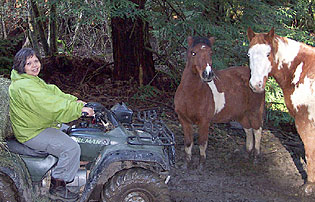
Vicki McCulley
Seventeen years ago, Vicki McCulley, then age 40, tried to show off while on the tire swing over her lawn as her family gathered for dinner on Easter Sunday.
"I was being a hotdog," admitted McCulley, a member of the Yurok, the largest Native American tribe in California. She fell, overextending her knee and tearing muscles and cartilage. Since then, she's had surgery to repair the meniscus cartilage, cortisone shots and various treatments aimed at reducing the ongoing pain in her knee.
By summer, the pain and accompanying stiffness was severely restricting McCulley's lifestyle.
"I'd been walking like a crab for a long time," she said. "I was always in pain. I just wanted to be able to walk with my grandkids, not run a marathon. It seemed like we'd go places and I'd end up sitting in the car."
McCulley's doctors in Humboldt County acknowledged that there were parts of her knee that had no cartilage, where it was bone on bone, but told her she was too young to have a knee replacement. Eventually her doctors, Katie Terra and Robert Lyle, at the Potawot Health Villages, operated by United Indian Health Services, referred her to UCSF Medical Center.
UCSF orthopaedic surgeon Kevin Bozic, who replaced part of McCulley's knee last August, said it used to be true that knee replacement was reserved for older adults because younger patients were considered too active. The artificial parts often wore out quickly in young patients, requiring another surgery. However, improvements in implant materials, less invasive surgical techniques and studies showing that knee replacement can substantially improve a person's quality of life suggest that more of these procedures can be offered to younger people. In fact, a National Institutes of Health conference on total knee replacement (TKR) in December 2003 concluded that knee replacement is a highly effective and relatively low-risk procedure that should be offered to more patients.
 |
| Vicki McCulley at home in Humboldt County. |
The UCSF Arthritis and Joint Replacement Center offers a full range of treatments for knees and hips that have been damaged by osteoarthritis, ranging from medication and lifestyle changes to partial and total joint replacement surgeries. New techniques using cameras and computers allow more accurate, less-invasive surgeries because the surgeon can see inside the body without having to make large incisions.
Since only one of the three compartments in McCulley's knee was damaged, she fell into the less than 10 percent of patients who qualify for partial knee replacement, a procedure that is done using small incisions, causing less trauma to the muscle and a shorter recovery period. One reason so few people qualify for partial replacement is that they wait until the osteoarthritis has progressed to the whole knee before seeking help. Early partial knee replacement may help prevent damage to other parts of the knee by restoring proper knee function, UCSF doctors say.
McCulley, who was interviewed about six weeks after the procedure, said the operation already has changed her life. She's able to help feed the dogs, cats, horses, goats, birds and rabbit that live with her and her family on their property outside of Eureka and is indulging in a host of other activities, with Bozic's permission.
She returned to her job as an advocate for crime victims in the Humboldt County District Attorney's office last November and continues to care for her two foster children, the last of a total of 75 kids she has raised in her home since 1986.
"It's like a whole new world," she said. "My older kids are having fits because I'm doing so much, but I've been tied down for so long."
Source: Sandra Burnett
From
To Our Neighbors, January-March 2005



